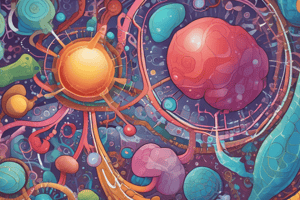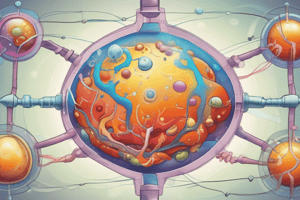Podcast
Questions and Answers
What is the difference between pyruvate and lactate molecules?
What is the difference between pyruvate and lactate molecules?
- Lactate has more hydrogen than pyruvate (correct)
- Pyruvate has more hydrogen than lactate
- Lactate has more carbon than pyruvate
- Pyruvate has more carbon than lactate
What is the direction of the reaction in lactic acid fermentation?
What is the direction of the reaction in lactic acid fermentation?
- Lactate is oxidised to pyruvate
- Lactate is reduced to pyruvate
- Pyruvate is reduced to lactate (correct)
- Pyruvate is oxidised to lactate
When does lactate production increase?
When does lactate production increase?
- When oxygen is abundant
- When the demand for ATP exceeds supply and oxygen is limiting (correct)
- When ATP supply exceeds demand
- When blood supply is increased
What is the byproduct of lactic acid fermentation?
What is the byproduct of lactic acid fermentation?
What percentage of nutrients are used to provide energy?
What percentage of nutrients are used to provide energy?
How long do nutrients absorbed from meals supply energy?
How long do nutrients absorbed from meals supply energy?
What do cells rely on for energy during a fasting state?
What do cells rely on for energy during a fasting state?
What is the preferred metabolic substrate for the brain?
What is the preferred metabolic substrate for the brain?
What happens when the brain lacks glucose?
What happens when the brain lacks glucose?
What is the energy use of the liver per day?
What is the energy use of the liver per day?
What is the function of 18F-2-deoxy-glucose (FDG) in imaging?
What is the function of 18F-2-deoxy-glucose (FDG) in imaging?
What is the preferred metabolic substrate for skeletal muscle?
What is the preferred metabolic substrate for skeletal muscle?
What is the total energy use of a 30-year-old, 66 kg woman?
What is the total energy use of a 30-year-old, 66 kg woman?
Which of the following tissues prefers glucose as a metabolic substrate?
Which of the following tissues prefers glucose as a metabolic substrate?
What is the product of glycolysis in the presence of oxygen?
What is the product of glycolysis in the presence of oxygen?
What is the energy yield from the electron transport chain?
What is the energy yield from the electron transport chain?
What is the product of fatty acid breakdown?
What is the product of fatty acid breakdown?
What is the role of the liver in amino acid oxidation?
What is the role of the liver in amino acid oxidation?
What is the byproduct of amino acid degradation?
What is the byproduct of amino acid degradation?
In what conditions does lactic acid fermentation occur?
In what conditions does lactic acid fermentation occur?
What is the energy yield from glycolysis?
What is the energy yield from glycolysis?
What is the product of the Krebs cycle?
What is the product of the Krebs cycle?
What is the role of CoA in fatty acid breakdown?
What is the role of CoA in fatty acid breakdown?
What is the byproduct of glycolysis in the absence of oxygen?
What is the byproduct of glycolysis in the absence of oxygen?
What is the primary source of energy for skeletal muscle?
What is the primary source of energy for skeletal muscle?
What is the approximate amount of ATP used by the heart per day?
What is the approximate amount of ATP used by the heart per day?
Which of the following is NOT a source of energy in a starving person?
Which of the following is NOT a source of energy in a starving person?
What is the approximate amount of ATP produced per gram of fatty acid?
What is the approximate amount of ATP produced per gram of fatty acid?
What percentage of cellular activity is driven by ATP?
What percentage of cellular activity is driven by ATP?
How long can the heart function without ATP production?
How long can the heart function without ATP production?
Study Notes
Cellular Respiration
- Glucose catabolism occurs in the presence of oxygen, producing ATP through glycolysis, intermediate reaction, Krebs cycle, and electron transport chain.
- ATP production under anaerobic conditions involves lactic acid fermentation.
Oxidation of Fatty Acids
- Fatty acid chains are broken into 2-carbon acetic acid molecules, which combine with enzyme CoA to form acetyl CoA.
- Acetyl CoA enters the Krebs cycle and electron transport chain, producing ATP.
Oxidation of Amino Acids
- Excess amino acids are transported to the liver, where they are degraded to produce sugars that can be converted to glucose or utilized in the Krebs cycle.
- Amino acid degradation involves the removal of the amino group (NH2) and an extra H to form ammonia (NH3), and the non-nitrogenous portion becomes a keto acid (ketone body).
Lactic Acid Fermentation
- Pyruvate is converted to lactate, which has more hydrogen compared to pyruvate, indicating that pyruvate is reduced to lactate.
- Lactic acid fermentation occurs when the demand for ATP exceeds supply and oxygen is limiting, such as during strenuous exercise or inadequate blood supply.
Nutrient Preferences of Tissues
- Brain: glucose, ketone bodies
- Skeletal muscle: fatty acids, glucose, ketone bodies
- Heart muscle: fatty acids, lactate, ketone bodies
- Red blood cells: glucose
- Many cancers: glucose (Warburg effect)
Cellular Energy Usage
- Not all parts of the body use energy at the same rate, with the brain, skeletal muscle, liver, heart, and kidneys being major energy consumers.
- Skeletal muscle can increase energy usage enormously, such as in woodchoppers who need 18,000 kJ a day.
ATP Production and Usage
- Aerobic metabolism of glucose produces much more energy than anaerobic metabolism (34 ATP vs 2 ATP).
- Fatty acids are not used to produce ATP in the absence of oxygen.
- ATP is the energy source for >95% of cellular activity, including contractility, ion pumping, signaling, and biosynthesis.
Starving
- Energy stores in a 70 kg person are depleted in the following order: glucose/glycogen, mobilizable proteins, and triglycerides.
- The brain, liver, muscle, and adipose tissue have different energy stores and usage rates during starvation.
Studying That Suits You
Use AI to generate personalized quizzes and flashcards to suit your learning preferences.




